The Holy Russia To The Soviet Russia..(Part 1)
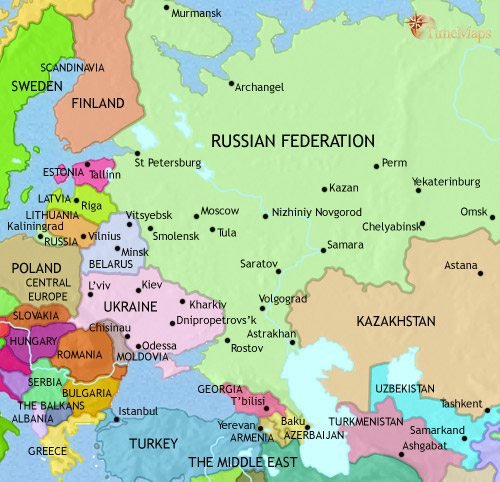
Current Borders Of Russia
Friends this is a long topic and I have divide it in 3 Major Parts i.e.;
1- The introduction to Russian Empire, its extent and economic expansion, Tsar Dynasty and Working classes & 1st uprising.
2- The Rise of Marxism and the revolution of 1905-07.
3- The Bolshevik Revolution and the end of Autocracy(i.e. the Tsar rule.).
When we talk about the top players of United Nations and the most strongest nations in this era of 'economic wars' we have only 3 nations on our list i.e. "USA, Russian Federation, The Republic Of China". But very few people know about the past of these nations. They were also like some common developing nations once fighting with internal problems, hunger, poverty autocracy etc.
The introduction to Russian Empire, its extent and economic expansion..
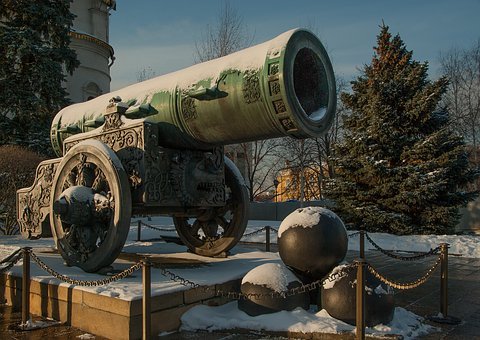
The abnormal Size Canons of Russian Empire
The Holy Russia(as it was called after the establishment of Tsar rule)after 1460s had begun to expand in Asia, the victory in Napoleonic Wars(In 1815, Tsar Alexander1 formed a Holy Alliance with other Emperors to defeat Napoleon.) gave it access to the future industrial rich regions of Poland. It had already conquered the Baltic region and Finland in 1809, Bessarabia in 1812. In south it extended till the Trans-Caucasian region(1859-64). In 1885 when the Indian National Congress was being formed in British India the Russian troops clashed with the Afghans at Pendjeh, they also fought with the British in this region and lost. Therefore, Russians turned their attention towards east. In east the acquired territories south of Amur River covering the vital warm water coast of Vladivostok(for Russians the importance for the search of accessible coast has always been the major cause of its expansion, like the Baltic conquest of 1809 to gain the western shores and now the conquest of Vladivostok in east.). The trans-Siberian Railways built b/w 1891-1904 which linked Vladivostok to Moscow was an important economic route for Russians in the period. The dream of eastern conquest of Russians came to an end in Russo-Japanese war of 1904-05 when the wanted the occupation of Manchuria for a better coastal access. The strong Russian Empire lost this war because of the internal economic disturbances going on due to the Tsar autocratic rule.
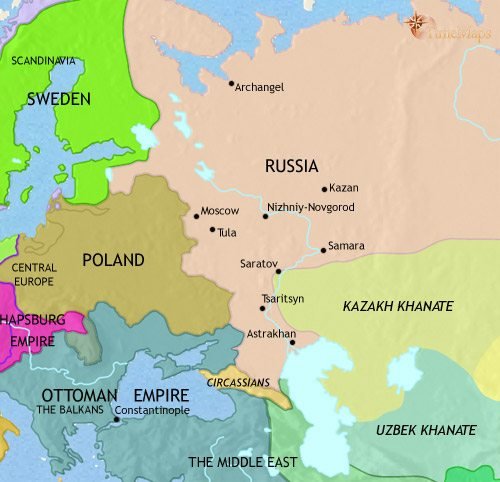
Russia of 1648AD
The economic development in Russian Empire was a continuous process from 18th till 20th century but due to the unquestioned autocracy prevalent in Russia this development could not reach the common masses. Therefore, Russia got industrialized economically on the week agricultural base just like India(before and after independence).it should be noted that the most successful country of 18th,19th century The Great Britain had a strong agricultural and rural base on which the Industrial revolution began in 1750s. In Russia also government induced the growth of railway and heavy industries but did not bother to educate or even feed their masses, as a result revolts started breaking out in different parts of the empire but they were all brutally suppressed by the ruling Tsars.
The Tsar Dynasty..
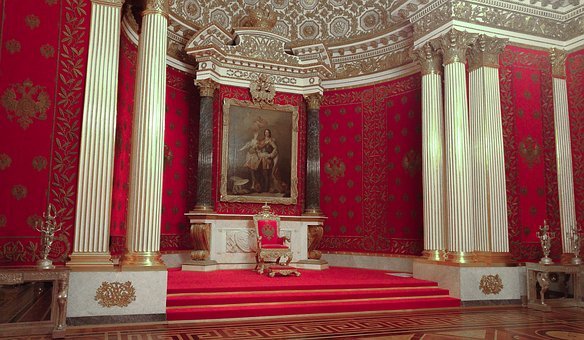
The Throne of Tsar
The "Holy Russia" as it was called by Tsars was built on the strong principles of authoritarianism and the Divine rule of the Tsar(or Caesar. The Tsar was also known as "The Little White Father" of everybody.). The eastern Orthodox churches were prevalent here and they were used by the ruling classes to distract the attention of masses from the important topics like political and economic condition of society. Actually, this structure of rule was inherited by the Tsar Dynasty from the Mongolian Empire of The Great Khan(Chengez Khan) which ruled over whole of the Asian continent (except south Asia). The last Mongolian rulers i.e. the Golden Horde were driven away from Russia by the Russian princes under the leadership of Prince of Moscow. Prince of Moscow gradually became powerful and adopted the title "Tsar". The reason why Moscow could prevail over other principalities was the geographical proximity of Moscow which gave it advantage not only of best Defense but also a great water transport center.
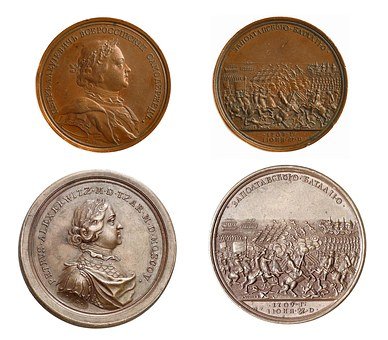
Coins depicting the image of Peter The Great..
Some of the rulers of Tsar Dynasty were actually worthy of rule and tried to improve the problem of the backwardness of Russian society like; Peter The Great(1689)was the 1st ruler who tried to westernize Russia. He copied many western thoughts and ideas to control his backward and ignorant nobility. Peter also started to expand Russia for the productive shores as he understood the power of navy and sea trade in those days of dark ages. He enlarged the functions of government and formed the '10 colleges or rudimentary ministries'. Peter himself supervised these collages and all the officials reported to him. He also encouraged his ministers to keep an eye on each other's work thereby developing the tradition of mutual suspicion and vertical communication with the Tsar. This feature remained in the Tsarist autocracy till the overthrow of the last Tsar, in fact this mutual suspicion and vertical communication became tone of the major reasons of the Tsarist downfall. Another remarkable ruler was Catherine The Great(1782), she killed her unworthy husband and ceased power. She was a strong, cruel and a women of extraordinary talent. She also looked west to improve the conditions of her court. She tried to copy the French court of Versailles, she also implemented educational reforms but only for the elite sections.
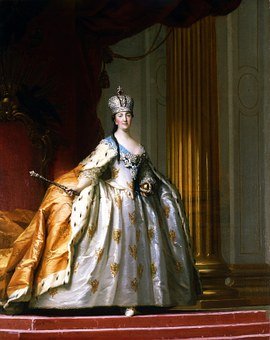
Queen Catherine The Great
Now if we analyze the mistakes of these two great rulers, we can conclude that "the Cultures may it be western or Oriental(of pertaining to east.)cannot be copied and suddenly imposed on people, it has to be fueled constantly for ages and in an equal ratio b/w all sections of society to avoid the gaps b/w the classes of society and the ultimate revolts and revolutions." Peter and Catherine by implementing these reforms in the limited sections of society simple strengthened the serfdom and autocracy in Russia. The masses literally had no choices of their own. They were tied to a land and could not leave their work without permissions. Many of the had to work for 12 hrs. a day on the land as serfs. Education was limited to elite sections(landed gentry)only. There was no middle class section and the masses were entirely illiterate and backward. So the progress in Russia(elite classes) moved forward will a parallel reactionary society moving towards the strive of revolutions. But with the outbreak of French Revolution the western thoughts trickled down towards the poor masses of Russia. As a result they started becoming educated and began to question the divine rule of Tsar. Many of them started demanding a representative form of government at local level.
Finally, the reforms of Tsar Alexander II(1880s) brought some hope in the educated intelligentsia. He carried out the abolition of Serfdom and formation of Zemstvos(a kind of municipality). But these reforms were carried out in an authoritarian manner by him. He brushed aside all the advices of educated class and only included elite section in Zemstvos. Due to his actions he faced a series of assassin attempts and finally in 1881 he was killed by a member of revolutionary party named-"Land and Freedom Society" formed in 1876. His successor Tsar Alexander III brutally crushed there terror activities and these so called revolutionaries had to leave Russia for nearly 2 decades.
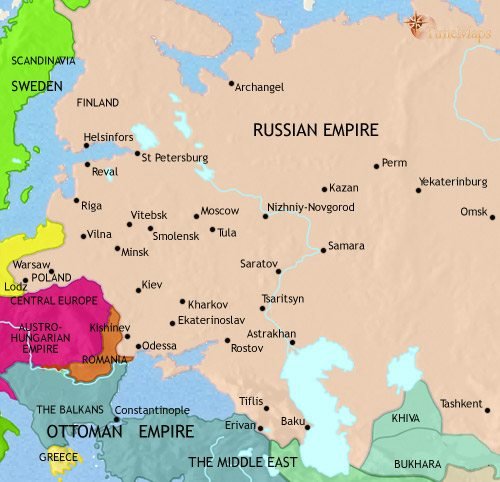
Russia during 1870s..
The Working Classes..
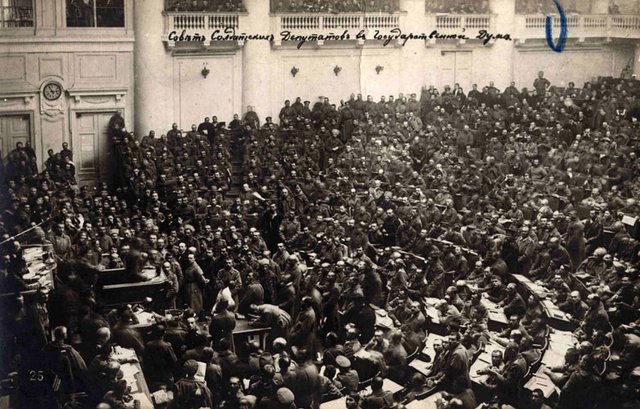
Assembly of Soviets(Worker's Assosiation)
I have already told u above that the Russian economic industrialization was based on week agricultural and social base." Now the workers of Russian factories were part peasants and part workers, they had strong roots into their village community even when they worked in large cities. Therefore, the discontent among these workers against the regime was duel in nature. They thus reacted not only to the sub humane conditions of factory workers but also the crushing burden of land taxes in villages". This was probably one of the root causes why the revolutionary movement took up pace.
Russian had a huge population of factory workers. There were approximately, 3million industrial workers of whom 550000 were working in textile factories, 500000 in metallurgical industries and 400000 in railways. The employers had no shortage of man power therefore, they irregularly paid of their workers and also made them work hard for longer hours. Their whole income went on collecting bread for themselves and barely some pennies were left for clothing. But after the stride of French Revolution the education level of workers started improving. Despite the censorships of Tsar on certain books and articles the workers started getting them illegally.
The 1st Uprising..!
As the education spread b/w the working classes, they began questioning the biased and unfair rules and regulations of Tsar regime. During the Napoleonic wars the soldiers of Tsar who had fought besides the advanced nation's forces like Britain and Prussia got the chance to examine the differences b/w the lives of people there and in Russia closely. When they reached home they started demanding reforms in government. The 1st major uprising in Russia was now evident in the name of Decembrist Uprising(1825), because it occurred in the month of December and the people who took part in it were known as 'Decembrists' . They formed secret societies for the constitutional and judicial reforms, for abolition of Serfdom which was still prevalent in Russia(ended by 'Alexander II' as told above), they also tried to raise voice against the foreign influence on Tsar's Russia.
The opportunity for action plan came when Tsar Alexander I suddenly died in 1825. the Decembrists tried to stop military from taking oath of allegiance to the new Tsar Nicolas unless he commits himself to the constitutional form of government, but they were only partly successful as most of the army sided with Tsar and the movement was crushed down. The revolutionaries were captured and were fired upon publically to death. Almost 300 men were killed and others were sentenced for hard labor and exiled to vast and cold Siberian Dessert.
The movement was certainly crushed but it was the beginning of the age of revolution in Russia as this event kept on inspiring the educated intelligentsia for Decades and finally shook the roots of Tsar rule in the revolution of 1905.
But the story of 1905 revolution will be taken up in next article. Hope everyone enjoyed reading the story of "The Holy Russia".
In the next part we will talk about the circumstances which led to the 1st ever "Socialist Revolution" in the world and why did this revolution took place in the backward and less industrialized country like Russia, when Karl Marx the pioneer of the Marxism(on which all other ideologies related to social domination are based like Socialism, Communism, Maoism etc.) declared in his work Das Capitalism that the 1st Socialist revolution would occur on the soil of industrially advanced nations like Germany or Britain as a result of clash b/w the intrests of Capitalist owners and common Workers.
Image sources..
Thanks bro for such an informative post. https://steemit.com/mgsc/@navesumar/how-to-file-a-case-in-consumer-courts
That’s great to hear about my neighbouring country!! Informative Civic post. Thanks (:
where are u from bro..
upvote for me please? https://steemit.com/news/@bible.com/2sysip
Good post... Russia is a one of the powerful country it's good to know their history..
Nice post @devsingh and DID you know the world richest man is not bill gates its Vladimir Putin the president of Russia.
ohh really..i didnt know...thanks
thanks for the great knowledge !
ohh putin ,i love this man.This man makes the russia such a powerful nation in the world
@devsingh really informative post my friend.